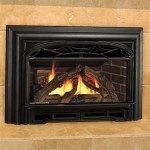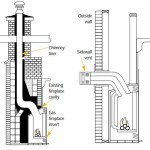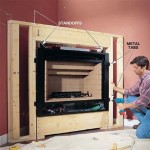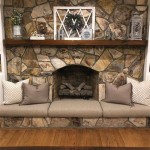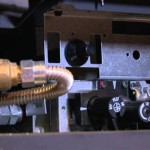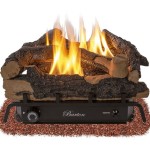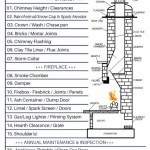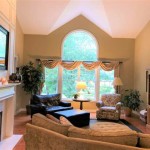White Bookcases Next To Fireplace: A Design Integration Exploration
The integration of white bookcases alongside a fireplace represents a common design choice aimed at achieving a balance between aesthetics and functionality within a living space. This configuration often seeks to create a focal point while simultaneously providing storage and display opportunities. The success of this design depends on several factors, including the architectural style of the home, the size and shape of the room, and the specific characteristics of the fireplace and bookcases themselves.
White, as a color, is frequently selected for its perceived versatility and its ability to reflect light, which can contribute to a brighter and more open feel in a room. When applied to bookcases, white can create a clean and unobtrusive backdrop for the items displayed, allowing books, decorative objects, and other personal belongings to take center stage. Conversely, a fireplace, often constructed of brick, stone, or other materials, can introduce texture and visual weight into the space. The contrast between the white bookcases and the fireplace can be visually appealing, but careful consideration must be given to the specific materials and textures involved to ensure a cohesive design.
This article will examine the key considerations involved in designing and implementing a layout featuring white bookcases next to a fireplace. It will explore aspects of spatial planning, material selection, safety precautions, and style considerations, providing a framework for understanding the nuances of this design arrangement.
Spatial Considerations and Bookcase Placement
One of the initial steps in planning this design arrangement involves assessing the spatial constraints of the room. The size and shape of the room will dictate the dimensions and placement of the bookcases. In smaller rooms, tall, narrow bookcases may be preferable to maximize vertical storage while minimizing the footprint. In larger rooms, wider bookcases or built-in units can be used to create a more substantial architectural feature. The distance between the bookcases and the fireplace is critical. Sufficient space must be maintained to allow for safe passage and to prevent the bookcases from becoming overheated by the fireplace.
The placement of the bookcases should also consider the overall traffic flow within the room. Bookcases should not obstruct doorways or pathways. Furthermore, the arrangement should enhance, rather than detract from, the existing architectural features of the room. For instance, if the fireplace is centered on a wall, the bookcases may be symmetrically arranged on either side to create a balanced and harmonious composition. Alternatively, an asymmetrical arrangement can be used to create a more dynamic and contemporary look. The placement of the bookcases also needs to account for any existing windows, doors, or other architectural elements that may impact the layout.
Consideration should be given to the accessibility of the bookcases. Shelves should be within easy reach, and if the bookcases are particularly tall, a step stool may be required. The depth of the shelves should also be considered, taking into account the types of items that will be stored or displayed. Deeper shelves can accommodate larger books and objects, while shallower shelves may be more suitable for smaller items.
Material Choices and Style Harmony
The selection of materials for both the bookcases and the fireplace is crucial to achieving a cohesive and aesthetically pleasing design. While the bookcases are white, the specific shade of white can vary considerably, from bright white to off-white or cream. The choice of white should complement the color palette of the room and the materials used in the fireplace. For example, if the fireplace is constructed of a warm-toned brick, a slightly warmer shade of white may be preferable for the bookcases. The finish of the bookcases, such as matte, satin, or gloss, can also affect the overall aesthetic. A matte finish may be more suitable for a traditional design, while a gloss finish can create a more modern and sleek look.
The materials used in the fireplace should also be considered in relation to the bookcases. If the fireplace is constructed of a natural stone, the texture and color of the stone should be taken into account when selecting the style and finish of the bookcases. For example, a rustic stone fireplace may pair well with bookcases made of wood with a distressed finish. Conversely, a more modern fireplace with clean lines may be complemented by bookcases with a minimalist design and a smooth, glossy finish. The overall style of the room should also guide the selection of materials. A traditional room may call for bookcases with ornate detailing and a classic design, while a contemporary room may benefit from bookcases with a simpler, more streamlined aesthetic.
Hardware choices, such as knobs and pulls, can also contribute to the overall aesthetic. The hardware should complement both the bookcases and the fireplace, and it should also be consistent with the style of the room. Metal hardware, such as brass or nickel, can add a touch of elegance, while wooden hardware can create a more rustic feel.
Safety and Practical Considerations
Safety is a paramount concern when placing bookcases next to a fireplace. The heat generated by the fireplace can potentially damage the bookcases or create a fire hazard. It is essential to maintain a safe distance between the bookcases and the fireplace, typically at least 12 inches, but it's prudent to check manufacturer guidelines for both the fireplace and the bookcase. Materials used in the construction of the bookcases should be fire-resistant or treated with a fire retardant. Wood is a commonly used material, but it is important to ensure that it is properly treated to reduce its flammability.
The contents of the bookcases should also be considered. Flammable materials, such as paper, should be stored away from the fireplace. A fire extinguisher should be readily accessible in the event of a fire. It is also advisable to install smoke detectors in the vicinity of the fireplace and bookcases. Regular maintenance of both the fireplace and the bookcases is essential to ensure safety. The fireplace should be cleaned regularly to remove soot and creosote, and the bookcases should be inspected for any signs of damage or wear.
Beyond fire safety, practical considerations also play a role. The bookcases should be sturdy and well-constructed to prevent them from tipping over. They should be securely anchored to the wall, particularly if they are tall or heavy. The weight of the contents of the bookcases should be evenly distributed to prevent overloading the shelves. The placement of electrical outlets should also be considered. Outlets may be needed for lighting or for powering electronic devices. The cords should be neatly concealed to prevent tripping hazards and to maintain a clean and organized appearance.

White Built In Bookshelves Around The Fireplace Green With Decor

White Built In Bookshelves Around The Fireplace Green With Decor

Fireplace Between Bookcases Design Ideas

Freestanding Fireplace Bookcases Design Ideas

Fireplace With Built Ins Inspiration Maison De Pax

Flanking The Fireplace Built In Bookcases Feature Beautiful Decor See Sources On Home B Shelves Living Room Bookshelves

Reader Question How Can I Build Symmetrical Bookcases Around This Fireplace Addicted 2 Decorating

Best Built In Bookshelves Around A Fireplace Design Ideas Living Room Renovation Shelves Decor

The Best Ideas For Built Ins Around A Fireplace Zhush

ᑕ❶ᑐ Fireplace Bookshelves Design Has Shiplap Set Sail
Related Posts

